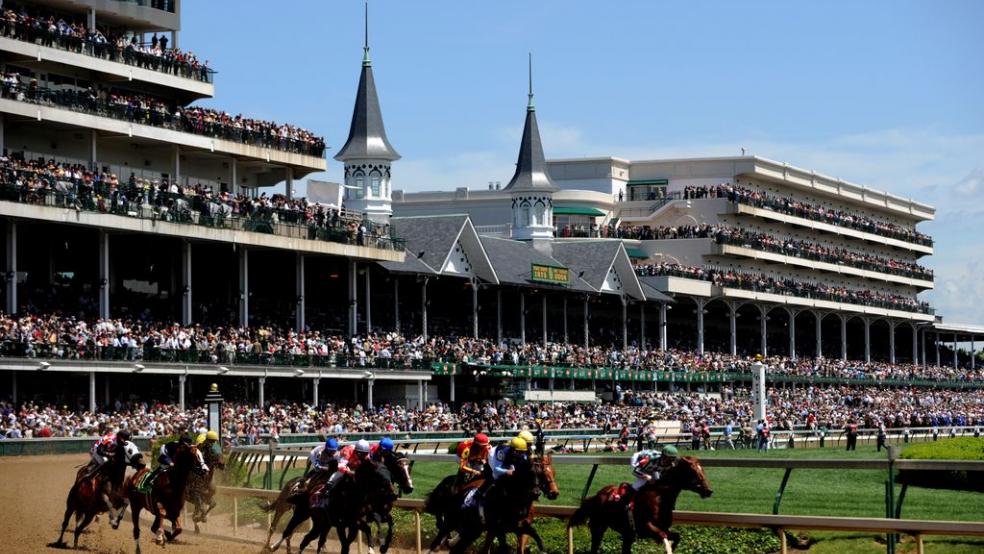Time to throw on your seersucker suit or most stylish sundress and slurp up your mint julep. The 142nd Kentucky Derby will be run Saturday at Churchill Downs Louisville. Last year, attendance at the race was a record 170,513 people and nearly 18 million people watched on television as American Pharoah won en route to becoming the first Triple Crown winner in 37 years.
But if you still think Pharoahs are only Egyptian or that a mint julep sounds like a kind of candy, brush up on your knowledge of the historic race by reading on:
Related: Kentucky Derby: The Value of a 2-Minute Horserace
What is the Kentucky Derby?
Topping off the two-week Kentucky Derby Festival, the Derby is the most popular annual horse race in the U.S. and is known as “the most exciting two minutes in sports.”
It’s also the oldest continuously running sporting event in the U.S., as it hasn’t missed a year since first being run in 1875. The race always takes place on the first Saturday in May.
Why is it a big deal?
Besides the longstanding tradition, the race also makes up the Triple Crown of American horse racing, along with the Preakness Stakes and the Belmont Stakes. Winning the Triple Crown is often thought of as the greatest accomplishment possible for a thoroughbred racehorse.
Oh, and there’s big money involved.
How much money is at stake?
People bet a record $194.3 million on the Derby last year, with $154.3 million being paid on winning tickets.
The prize money isn’t bad, either. The winning owner receives $1.4 million in prize money. Second place receives $400,000, third place receives $200,000, fourth place receives $100,000 and fifth place receives $60,000.
Related: A Bettor’s Guide to the Kentucky Derby
The winner also receives a trophy that is made of 14 karat gold, is 22 inches tall, stands on a jade base and weighs 3.5 pounds. On top of that, the winning horse wears a hand-sewn garland of 400 roses that weighs more than 40 pounds.
Six other big races will also be taking place at Churchill Downs on Sunday, which will dish out another $2.15 million to winners.
How do the Kentucky Derby horses get chosen?
The race is limited to 20 three-year-old thoroughbreds who are eligible for the race based on their performance in 36 other stakes races, making it a very exclusive event. Owners pay at least $50,600 to enter their horse in the field. In 2013, around 21,275 thoroughbred foals were born in the U.S. That means less than one-tenth of one percent of them will make it to the Derby. And if they do somehow make it, they only have one shot at the winning roses.
Who’s this year’s favorite?
Nyquist, the winner of the Florida Derby, is the betting favorite for this year’s race. A couple other horses are also worth a look. Santa Anita Derby victor Exaggerator and Fountain of Youth winner Mohaymen are other top choices on the betting lines.
Related: Kentucky Derby: Big-Time Economic Win
What are some of the traditions behind the Derby?
Hats are a big one. Women wear big, ridiculous, flamboyant hats. Almost all of the hats worn come with a lavish assortment of flowers, ribbon and feathers. The tradition of the big hat dates back to the race’s founder, Col. Meriwether Lewis Clark, who wanted to make the event appeal to the upper class and pushed people attending the race to wear their nicest clothes. Back then, that included a hat. Although headwear hasn’t remained an American tradition, it certainly has at the Derby.
The Derby also has its own drink, the mint julep. Fans consume an estimated 127,000 juleps on Derby day and Kentucky Oaks day the Friday before. A mixture that consists of sugar, fresh mint and whiskey, the mint julep has been the traditional cocktail of the Derby since they were first served at the event in 1938.
A thick, meaty stew called Burgoo is the traditional food of the Derby. Although there are many recipes for the dish, the most typical one contains three types of meat along with corn, butter beans and okra.





